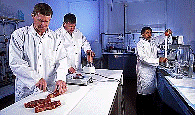United States Department of Agriculture: Agricultural Research Service, Lincoln, Nebraska

Roman L. Hruska U.S. Meat Animal Research Center: Reports
Date of this Version
2006
Document Type
Article
Citation
The Professional Animal Scientist 22 (2006):450–453
Abstract
Feedlot performance records from the U.S. Meat Animal Research Center feedlot for 1993 through 2000 were analyzed to evaluate the impact of foot rot on ADG and total days on feed. Records from the original pool of 36,755 bull, steer, and heifer calves were sorted so that only steers that had a single foot rot incidence and no other morbidities were included in the data set (7,100 steers). To roughly pattern these data to industry production practices, time of foot rot insult during feeding was divided into 3 production periods: starting (0 to 60 d), growing (61 to 120 d), and finishing (121 d to harvest). Records were evaluated to determine which limb was more likely to be affected with foot rot. A total of 459 (6.5%) steers were treated for a single foot rot incident. The ADG for cattle not affected by foot rot was 1.30 kg. For cattle experiencing a single foot rot incident, the ADG was 1.27 kg (P = 0.03). The production period of foot rot onset impacted both ADG and total days on feed. Steers diagnosed with foot rot during the starting period gained 0.032 kg/d more (P = 0.083) than non-affected steers. Steers diagnosed in the growing and finishing periods gained 0.009 and 0.049 kg/d less than non-affected cattle (P = 0.438 and P < 0.01, respectively). Mean days on feed for the non-affected cattle was 262 d and mean days on feed for foot rot-affected cattle was 267 d (P < 0.01). The impact of foot rot on days on feed for periods 1 through 3 was −9.9 d, +2.2 d, and +14.3 d (P < 0.01, P = 0.26, P < 0.01, respectively). Foot rot diagnosed in either front limb reduced (P = 0.014) BW gain by 0.031 kg.

